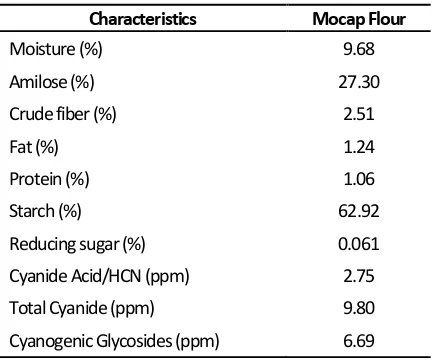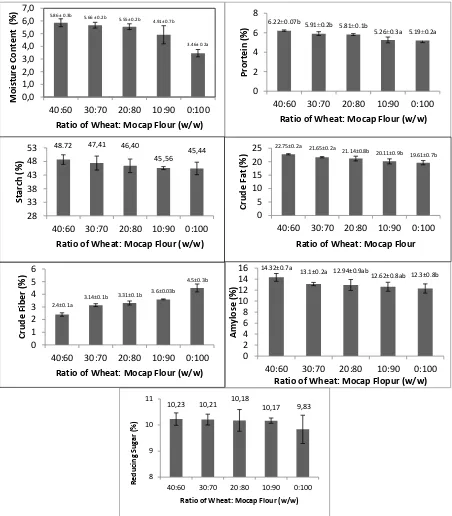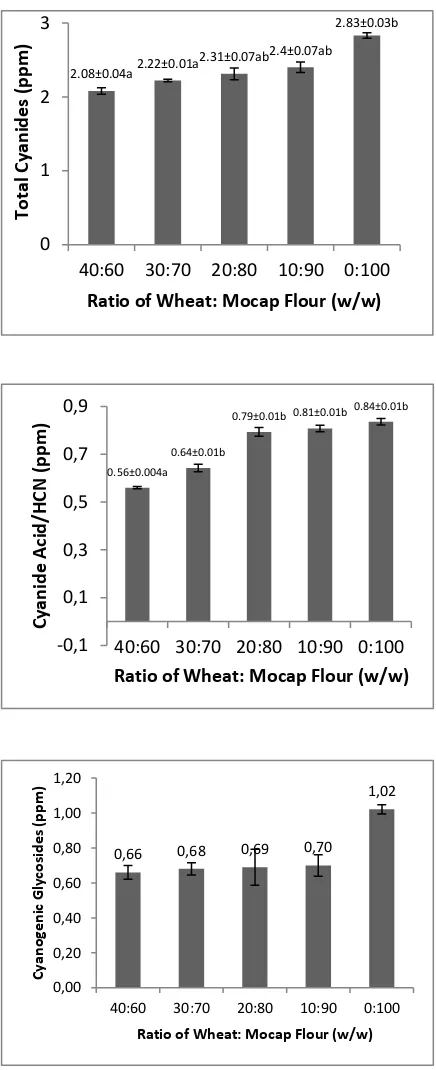Chemical Characteristics of Biscuit Substituted by Modified Cassava Product
(Mocap) Flour from High Cyanide Variety of Cassava
Harijono1, Maimunah Hindun Pulungan2, Jhauharotul Muchilisyiyah1, Erna Triyas Tanti1, Teti Estiasih1*
1 Department of Agricultural Product Technology, Faculty of Agricultural Technology, University of Brawijaya
2 Department of Agroindustial Technology, Faculty of Agricultural Technology, University of Brawijaya
Email*: [email protected]
ABSTRACT
Cassava (Manihot esculenta Cranzt) is easily cultivated and an important source of carbohydrates. Currently, only a certain type of low cyanide cassava has been utilized for food product and intermediate product as flour. Processing of high cyanide cassava through submerged and solid-state fermentation simultaneously into mocap (modified cassava product) flour has successfully lowered the cyanide into a safe level for consumption. The application of mocap flour for biscuit is important to know the characteristic changes that occur due to substitution of mocap flour. Variations of wheat flour: mocap flour of 40:60, 30:70, 20:80, 10:90, and 0:100 were used in the preparation of biscuits. The resulting biscuits were analyzed for their chemical characteristics including moisture, protein, fat, starch, amylose, crude fiber, reducing sugars, and cyanide compounds. The cyanide compounds comprised of total cyanide, HCN, and cyanogenic glycosides.
Substitution of wheat flour by mocap flour in biscuit making produced the changes of biscuit characteristics. Protein, moisture, starch, amylose, fat, and reducing sugar content was decreased by increasing substitution of mocap flour. Meanwhile, crude fiber and cyanogenic compounds increased by increasing mocap flour substitution. All biscuits with variation of
mocap flour substitution were safe to consume because of low level of cyanides. Keywords: biscuit; cassava; cyanide; fermentation; substitution.
INTRODUCTION
Based on HCN content, cassava is divided into sweet/non-bitter, with HCN content <40 mg/kg fresh tuber, and bitter
cassa a ith HCN ≥50 mg/kg fresh tuber.
High content of HCN can cause poisoning for humans and animals, so it isn’t recommended to consume freshly (Sundari, 2010). Cassava consists of various varieties such as Malang, UJ, Darul Hudayah, and Adira, which have different cyanide acid (HCN) content (BBPPTP, 2008). The utilization of high cyanide cassava is generally used as tapioca raw material (Sundari, 2010). Cassava flour is usually processed from low cyanide cassava. Therefore, high cyanide cassava has limited utilization because cyanide is a toxic compound (FSANZ, 2005).
processing of garri there is a decrease of cyanide (Irtwange and Achimba, 2009). Similarly, in the processing of fufu as a processed product of traditional West African cassava there was a decrease in cyanide content (Oyewole and Ogundele, 2001; Achi and Akomas, 2006; Uyoh et al., 2009). Cyanide arises from the hydrolysis of a cyanogenic glycoside compound in cassava tuber by an endogenous linamarase enzyme. This hydrolysis will produce glucose and cyanohydrin acetone (Keresztessy et al., 2001). According to Mkpong et al. (1990), the cyanohydrin acetone will dissociate spontaneously at pH >5 or enzymatically by hydroxynitrile liases to form HCN and acetone.
Indonesian people have local wisdom in processing cassava. Various traditional processing process commonly done by the community is making cassava tape, growol, tiwul, gatot, kabuto, etc. Some of the traditional processing is a fermentation process involving various microbes such as bacteria, yeasts, and molds. One of the local
isdo of processi g is gadu ga pohu g
processing. Gadu ga pohu g processi g consists of soaking cassava chips followed by solid fermentation (solid state fermentation). This processing produces a white cassava product. Cassava bitter can be processed through gadu ga pohung so it is safe for consumption (Harijono and Wulan, 2008).
During the fermentation process, there are changes that cause changes in the characteristics of mocap flour compared to cassava flour without fermentation. Application of mocap flour on starchy food products is important to study. One of the products that use wheat as its ingredient is biscuit. The flour substitution with mocap flour on biscuit processing is interesting to be studied including cyanide change during processing. state fermentation, wheat flour, margarine, eggs, refined sugar, lecithin, butter, salt, baking powder, and skim milk. Reagents for analysis were anhydrous glucose, amylose, aquadest, Nelson A and B reagents, arsenomolybdate reagent, phenolphtaleine indicator, NaOH, iodine, petroleum ether, K2SO4, HCl, H2SO4, KI, acetic acid, ethanol, filter paper, Whatman No 40-filter paper, phosphate buffer pH 6, barbituric acid, pyridine, and phosphoric acid.
Modified Cassava Product (Mocap) Flour Preparation.
Cassava was peeled, washed, and grated. Then grated cassava was soaked in water for 3 days for submerged fermentation and ratio of grated cassava: water = 1:1. After 3 day submerged fermentation, the fermented grated cassava was drained for 1 hour, then put into a bamboo container. Cassava was fermented in solid state fermentation for 3 days in dark and humid places. After fermentation finished, cassava was dried for 7 hours at 60° C, milled, and sieved 80 mesh.
Biscuit Preparation.
Egg was stirred to foam then emulsifiers, butter, rum butter and sugar were added and mixed thoroughly. Wheat flour with mocap flour with a ratio according to treatment (40:60, 30:70, 20:80, 10:90, 0:100 w/w) were mixed with skim milk, salt, and baking soda. The egg mixture was mixed with flour mixture and stirred until smooth. Then the dough is formed with a size of 3x3 cm and baked for 30 minutes at 180°C.
Chemical Analysis.
reducing sugar, amylose fat, crude fiber (AOAC, 2005), HCN, total cyanide, cyanogenic glycosides (Bradbury, 1991). Fresh cassava tuber of Malang 4 variety was analyzed for HCN total cyanides, and cyanogenic glycosides (Bradbury, 1991).
Data Analysis.
Experiment was performed in completely randomized design with four replications. All data was analyzed by analysis of variance and DMRT in the case the ratio of wheat: mocap flour significantly affected dependent variable. Data was presented in mean ± standard deviation.
RESULTS AND DISCUSSION
The main ingredients used in this study were mocap flour (modified cassava product) and wheat flour (Table 1). Mocap flour is a cassava flour product which processed using submerged and solid state fermentation, and during fermentation the growing microbes produce enzymes that can destroy cassava cell walls. Subagio (2006) noted that fermented cassava flour generally involves microbes that destroy cell walls that can lead to the release of starch granules resulting in characteristic changes in flour such as increased viscosity, gelling property, rehydration, and solubility.
Table 1. Mocap flour characteristics
Characteristics Mocap Flour
Moisture (%) 9.68
Amilose (%) 27.30
Crude fiber (%) 2.51
Fat (%) 1.24
Protein (%) 1.06
Starch (%) 62.92
Reducing sugar (%) 0.061
Cyanide Acid/HCN (ppm) 2.75
Total Cyanide (ppm) 9.80
Cyanogenic Glycosides (ppm) 6.69
Fresh cassava variety of Malang 4 had total cyanides of 346 ppm that comprised of 4.5 ppm HCN, 338 cyanogenic glycosides, and 3.5 ppm acetone cyanohydrins. Fermentation of grated cassava tuber by submerged and solid-state fermentation significantly reduced cyanogenic compounds in cassava. Modified cassava flour had total cyanides of 10 ppm. Adepoju et al. (2010); Kobawila et al. (2005); Obilie et al. (2004); Padonou et al. (2009); Wahyuni et al. (2016) noted that reduction of cyanogenic compounds presumably related to microbial activity during both fermentation and dissolution of cyanogenic compounds into fermenting medium during submerged fermentation. Cyanogenic compounds decrease occurs during spontaneous fermentation. Therefore, mocap flour was safe to use as ingredient for food products.
Characteristics of biscuit substituted by mocap flour were shown in Figure 1. Some significant changes occurred in moisture, protein, crude fat, crude fiber, and amylose, because of different ratio of wheat to mocap flour. Meanwhile, starch and reducing sugar content did not change significantly. Decrease of biscuit compounds was found in moisture, protein, starch, crude fat, and amylose by the increasing substitution of mocap flour to wheat flour. Conversely, increasing component was found in crude fiber. The changes of chemical constituent of biscuit due to mocap flour substitution were related to different composition between mocap flour and wheat flour.
2008) including in the biscuit. Increasing protein content by decreasing proportion of mocap flour was related to protein content in wheat and mocap flour. Wheat flour had higher protein that mainly consisted of gluten (Wieser and Kieffer, 2001). Gluten proteins are hardly soluble in water and completely
insoluble once they are thermally aggregated. Cohesiveness of these samples in water can therefore be attributed to a gluten network (Chevallier et al., 2000). Lower gluten implied on the structure and cohesiveness of biscuit.
Figure 1. Chemical characteristics of biscuit substituted by modified cassava product (mocap) flour.
6.22±0.07b 5.91±0.2b 5.81±
40:60 30:70 20:80 10:90 0:100
P
Ratio of Wheat: Mocap Flour (w/w)
5.86 ± 0.3b 5.66 ± 0.2b
40:60 30:70 20:80 10:90 0:100
M
Ratio of Wheat: Mocap Flour (w/w)
22.75±0.2a 21.65±0.2a 21.14±0.8b
40:60 30:70 20:80 10:90 0:100
C
Ratio of Wheat: Mocap Flour
14.32±0.7a
40:60 30:70 20:80 10:90 0:100
A
Ratio of Wheat: Mocap Flopur (w/w)
10,23 10,21 10,18 10,17 9,83
8 9 10 11
40:60 30:70 20:80 10:90 0:100
R
Ratio of Wheat: Mocap Flour (w/w)
2.4±0.1a
40:60 30:70 20:80 10:90 0:100
C
Ratio of Wheat: Mocap Flour (w/w)
48.72 47,41 46,40
40:60 30:70 20:80 10:90 0:100
S
Starch content decreased by increasing mocap flour because mocap flour had lower starch. Starch was responsible to structural properties of biscuit. Partially gelatinization starch during baking of biscuit had a role in cohesiveness of biscuit. Crude fiber increased as mocap flour proportion increased. Mocap flour had higher crude fiber than wheat flour. According to Brennan and Samyue (2004), a reduction in visco-pasting properties (peak viscosity and final viscosity) of the flour– dietary fiber systems occurred with increasing fiber content. Addition of dietary fiber into the biscuits affected biscuit shrinkage and height development during cooking, as well as generally reducing the resistance of biscuits to snapping during texture analysis tests.
Fat also decreased by increasing content, amylose content decreased by increasing mocap flour proportion. When starch is heated in the presence of water, the granules imbibe water, swell and some amylase leaches into the solution–starch gelatinization (Raymundo et al., 2014). Reducing sugar increased by increasing mocap flour proportion. It was seemed that mocap flour had lower reducing sugar than wheat flour.
Figure 2 showed the changes of cyanogenic compounds by increasing proportion of mocap flour. Cyanogenic compounds comprised of free HCN, cyanogenic glycosides, and aceton cyanohydrin. Varieties containing high amounts of cyanogenic glucosides (linamarin and lotaustralin) can be hydrolyzed to HCN by indigenous enzymes
(linamarase), when plant tissue is damaged during harvesting, processing or other mechanical processes (Oboh and Akindahunsi, 2003). Cyanogenic glycosides can be defined
as α-hydroxynitrile glycosides and are
included into plant secondary metabolites. These glycosides are derivatives of plant amino acids. The biosynthetic precursors of cyanogenic glycosides differ from L-amino acids, which are hydroxylated, then N-hydroxylamino acids converted into aldoximes, then converted to nitriles and
h dro lated to α-hydroxynitriles, then
subjected to glycosylation to cyanogenic glycosides (Vetter, 2000). Almost all
c a oge ic gl cosides ha e β-bonds, generally
with D-glucose (FSANZ, 2005).
All biscuits with different proportion of wheat and mocap flour showed low level of cyanogenic compounds. Low level of cyanogenic compounds in biscuits was caused by their low level in mocap flour. All cyanogenic compounds (free HCN, cyanogenic glycosides, and total cyanogenic) increased by increasing proportion of mocap flour. Wheat flour doesn’t contain cyanogenic compounds. Based on the result of cyanogenic compounds analysis, it can be concluded that biscuit substituted by mocap flour was safe to consume.
25 cyanogenic glycosides are found in human food-consuming parts, including amygladin (in almonds); Dhurrin (sorghum); Linamarin
(cassava, lentils); Lotaustralin (cassava, lentils); Prunasin (stone fruit); And taxiphyllin (bamboo shoots) (FSANZ, 2005).
Figure 2. Cyanogenic compounds of biscuit substituted by modified cassava product (mocap) flour. 2.08±0.04a2.22±0.01a
40:60 30:70 20:80 10:90 0:100
T
Ratio of Wheat: Mocap Flour (w/w)
0.56±0.004a
40:60 30:70 20:80 10:90 0:100
C
Ratio of Wheat: Mocap Flour (w/w)
0,66 0,68 0,69 0,70
40:60 30:70 20:80 10:90 0:100
C
CONCLUSIONS
Substitution of wheat flour by mocap flour in biscuit making produced the changes of biscuit characteristics. Protein, moisture, starch, amylose, fat, and reducing sugar content was decreased by increasing substitution of mocap flour. Meanwhile, crude fiber and cyanogenic compounds increased by increasing mocap flour substitution. All biscuits with variation of mocap flour substitution were safe to consume because of low level of cyanides.
ACKNOWLEDGEMENT
All authors very grateful and would like to thanks to Ministry of Research, Technology, and Higher Education, Republic of Indonesia for funding this research through Excellent Research of Higher Education (PUPT) with contract No. 137/SP2H/LT/DRPM/III/2016.
REFERENCES
Adepoju, O. T., Adekola, Y. G., Mustapha, S. O., & Ogunola, S. I. (2010) Effect of processing methods on nutrient retention and contribution of cassava (Manihot spp) to nutrient intake of Nigerian consumers. African Journal of
Food Agriculture and Nutrition
Development, 10, 2099-2111.
Achi, O. K. & Akomas, N. S. (2006). Comparative assessment of fermentation techniques in the processing of fufu, a traditional fermented cassava product. Pakistan Journal of Nutrition, 5, 224-229. Association of Official Analytical Chemists
(AOAC). (2005). Official Methods of Analysis of the Association of Official Analytical Chemists. AOAC, Inc. Arlington. Virginia.
BBPPTP. 2008. Teknologi Budidaya Ubi Kayu. Balai Besar Pengkajian dan Pengembangan Teknologi Pertanian,
Balai Penelitian dan Pengembangan Pertanian. Jakarta.
Bradbury, J. J., Egan, S. V., & Lynch, M. J. (1991). Analysis of cyanide in cassava using acid hydrolysis of cyanogenic glucosides. TheJournal of Science Food and Agriculture, 55,211-290.
Brennan, C. S. & Samyue, E. (2004). Evaluation of starch degradation and textural characteristics of dietary fiber enriched biscuits. International Journal of Food Properties, 7, 647-657. Chevallier, S., Colonna, P., Bule´on, A. &
Valle, D. G. (2000). Physicochemical behaviors of sugars, lipids, and gluten in short dough and biscuit. Journal of Agricultural Food Chemistry, 48, 1322-1326.
Duggan, E., Noronha, N., O’Riorda , E. D., &
O’“ulli a . (2008). Effect of resistant
starch on the water binding properties of imitation cheese. Journal of Food Engineering, 84, 108–115.
Harijono & Wulan, S. N. (2008). Pengolahan Ubi Kayu. Laporan Penelitian, Fakultas Teknologi Pertanian, Universitas Brawijaya, Malang.
FSANZ. 2005. Cyanogenic Glycosides in Cassava and Bamboo Shoots. A Human Health Risk Assessment Technical Report Series No 28. Food Standards Australia New Zealand.
Hosel, W. (1981). The Enzymatic Hydrolysis of Cyanogenic Glucosides. In B. Vennesland, E. E. Conn, C. J. Knowles, J. Westley, and F. Wissing (Eds.), Cyanide in Biology. Academic Press, London. pp 217-232.
Keresztessy, Z., Brown, K., Dunn, M. A., & Hughes, M. A. (2001). Identification of essential active-site residue in the
c a oge ic β-glucosidase (linamarase)
from cassava (Manihot esculenta
Crantz) by site-direct mutagenesis. Journal of Biochemistry, 353, 199-205. Kobawila, S. C., Louembe, D., Keleke, S., Hounhouigan, J., & Gamba, C. (2005). Reduction of the cyanide content during fermentation of cassava roots and leaves to produce bikedi and ntoba mbodi, two food products from Congo. African Journal Biotechnology,
4, 689-696.
Manohar, R. S., & Rao, P. H. (1999). Effect of emulsifiers, fat level and type on the rheological characteristics of biscuit dough and quality of biscuits. Journal of the Science Food and Agriculture,
79, 1223-1231.
Mkpong, O. E., Yuan, H., Chism, G., & Sayre, R.T. (1990). Purification, characterization and localization of linamarase in cassava.Plant Physiology, 93, 176-181. Moller, B. L. & Seigler, D. S. (1999). Biosynthesis of cyanogenic glycosides, cyanolipids and related compounds. In B.K. Singh (ed.). Plant Amino Acids Biochemistry and Biotechnology.
Marcel Dekker. pp. 563-609.
Obadina, O., Oyewole, O. B., & Odusami, A. O. (2009). Microbiological safety and quality assessment of some fermented cassava products (lafun, fufu, gari).
Scientific Research and Essay, 4, 432-435.
Obilie, E. M., Tano-Debrah, K., & Amoa-Awua, W. K. (2004). Souring and breakdown of cyanogenic glucosides during the processing of cassava into akyeke. International Journal of Food Microbiology, 93, 115-121.
Oboh, G. & Akindahunsi, A. A. (2003). Biochemical changes in cassava products (flour and garri) subjected to Saccharomyces cerevisae solid media fermentation. Food Chemistry, 82, 599-602.
Oyewole, O. B. & Ogundele, S. L. (2001). Effect of length of fermentation on the functional characteristics of fermented cassava 'fufu'. The Journal of Food Technology in Africa, 6, 38-40. Padonou, S. W., Hounhouigan, J. D., & Nago, M. C. (2009). Physical, chemical, and microbiological characteristics of lafun produced in Benin. African Journal of Biotechnology, 8, 3320-3325.
Raymundo, A., Fradinho, P., Nunes, M. C. (2014). Effect of Psyllium fibre content on the textural and rheological characteristics of biscuit and biscuit dough. Bioactive Carbohydrates and Dietary Fibre, 3,96–105.
Rahayu, E. S., Okada, S., Uchimura, T. & Komagata, K. (1999). Lactic acid bacteria in fermented foods of indonesian origin. Asian Network on Microbial Research Symposium on Microbial Diversity. The Asian Scene, Singapore, 22-24 February 1999. Subagio, A. (2006). MOCAL Sebuah
Ketahanan Pangan Masa Depan Berbasis Potensi Lokal. Fakultas Teknologi Pertanian Universitas Jember. Jember.
Sundari, T. (2010). Petunjuk Teknis Pengenalan Varietas Unggul dan Teknik Budidaya Ubi Kayu (Materi Pelatihan Agribisnis Bagi KMPH). Report No. 55.STE. Final. Balai Penelitian Kacang Kacangan dan Umbi Umbian, Malang.
physicochemical and sensory properties of fufu. Pakistan Journal of Nutrition, 8, 1123-1125.
Vetter, J. (2000). Plant cyanogenic glycosides. Toxicon, 38, 11-36.
Wahyuni, S., Ansharullah, Saefuddin, Holilah, & Asranudin (2016). Physico-chemical properties of Wikau maombo
flour from cassava (Manihotesculenta
Crantz). IJCEBS, 4, 134-137.


